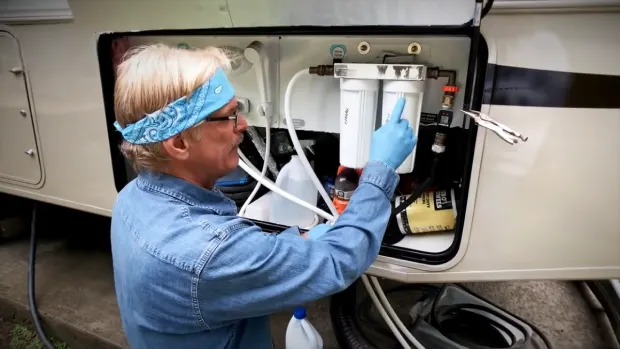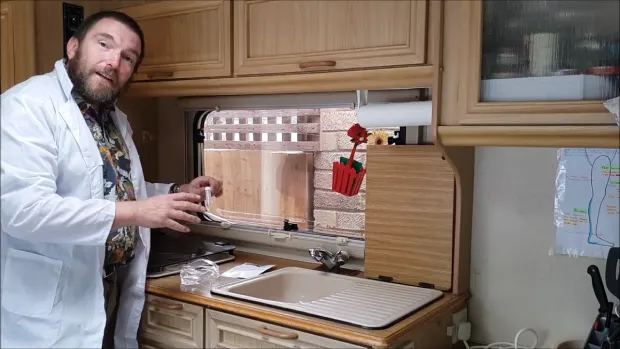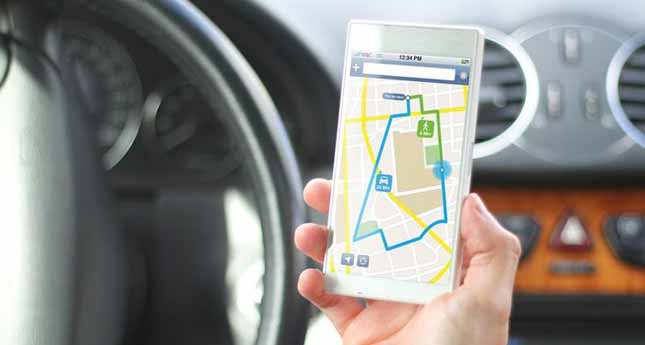Last Updated on June 4, 2023
Safety concerns arise when drinking water from the onboard tank of a motorhome. Local authorities monitor water quality supplied to RV parks, but no such regulations exist for motorhome tanks. As a result, it’s essential to evaluate whether or not this practice poses any risks.
Although it’s totally fine to drink water from your motorhome fresh water tank if you regularly disinfect and sanitize your motorhome tank and water system.
But it is best to avoid drinking water directly from the motorhome gray water tank because it contains harmful bacteria and viruses, chemicals and heavy metals, algae, and other organic matter. However, these water tanks can be treated to be consumed.
We will discuss the potential hazards associated with drinking water stored in RV tanks today and how to ensure your drinking water is safe while on the road.
Why It May Not Be Safe to Drink Directly Water from a Motorhome Tank? Potential Contaminants

Water is an essential resource we need to consume daily. However, drinking water from a motorhome tank directly might not always be safe due to its potential contaminants, such as:
Harmful Bacteria and Viruses
Harmful bacteria and viruses are also a major concern when drinking water from these tanks. These microorganisms can cause serious illnesses that may lead to hospitalization or even death.
Bacteria such as E.coli and Salmonella are commonly found in contaminated water sources and can be transmitted through ingestion. Similarly, viruses like Hepatitis A and Norovirus can be contracted by drinking contaminated water.
It is important to note that while some RVs have built-in filtration systems, they do not always effectively remove all harmful pathogens. Take a look at this table to see what bacteria and viruses can do to you:
| Contaminant | Symptoms | Prevention |
| E.coli | Abdominal cramps, diarrhea, vomiting | Regular sanitization of the water tank |
| Salmonella | Fever, abdominal pain, diarrhea | Use of quality filtration system |
| Hepatitis A | Fatigue, nausea/vomiting, jaundice | Avoid questionable water sources |
Chemicals and Heavy Metals
Water in a motorhome tank may contain certain chemicals and heavy metals. These substances can negatively affect humans if consumed regularly or in high amounts.
Chemicals such as lead, copper, and zinc, commonly found in pipes and fittings used for the water system of recreational vehicles, can cause gastrointestinal distress, headache, and even kidney damage. Exposure to these substances over long periods of time has been linked to cancer.
Also, many RV owners use treatments like chlorine tablets or liquid bleach to sanitize their tanks before filling them with water. While these agents effectively reduce bacteria growth, they also introduce potentially harmful chemicals into the water supply.
Chlorine, when ingested frequently or in large quantities, can irritate mucous membranes and induce respiratory problems.
Algae and Other Organic Matter
Algae are photosynthetic organisms that thrive in warm, moist environments with sunlight exposure. They can accumulate on the walls of water tanks, pipes, and fixtures when left unchecked. These microorganisms affect the taste and smell of drinking water and pose health risks to humans.
Other types of organic matter, such as fungi, and protozoa may also grow in motorhome water tanks. Fungi like Aspergillus SPP, Candida Albicans, and Cryptococcus Neoformans can cause respiratory infections when ingested or inhaled through mist or aerosols containing their spores.
Pre-Trip Motorhome Tank Maintenance to Get Potable Water

Maintaining the cleanliness and safety of your motorhome’s water tank is crucial for ensuring a safe drinking experience. Before embarking on any trip, conducting some pre-trip maintenance checks on your water system is necessary.
This includes:
Flushing and Sanitizing Your Water Tank
To ensure that the water from your motorhome tank is safe to drink, it’s important to flush and sanitize the tank regularly. This process involves removing any debris or sediment that may have accumulated in the tank and disinfecting the entire system.
The first step in flushing and sanitizing your water tank is to drain all the stored water out of the system. Once this has been done, you can use a specialized cleaning solution designed for RV motorhome tanks to clean the inside thoroughly.
After cleaning, it’s essential to rinse the tank with fresh water several times to remove any remaining residue or cleaning solution. You should also replace an RV water filter during cleaning if you have been using it for at least six months.
RV water filters last 3 to 6 months, as they can become clogged with dirt and debris, making them less effective. Once you have completed the cleaning process, fill your tank with fresh drinking water and disinfect it before use.
Things to consider when choosing a cleaning solution:
- The type of material used for your RV’s water tank
- Any personal allergies or sensitivities
- Environmental considerations such as biodegradability
Using Water Filters and Purifiers
Water filters are designed to remove impurities from water while maintaining its essential minerals. These devices pass the water through a porous material or membrane that traps any substances larger than the pores’ size. Some filters may also use activated carbon to absorb organic compounds like chlorine or pesticides.
Most filter systems are easy to install and maintain, making them an ideal addition for those who frequently travel in motorhomes.
Purifying agents like ultraviolet (UV) light or chemical treatments can be used alongside filtration systems for extra safety. UV light destroys microorganisms by damaging their DNA structure, rendering them unable to reproduce or cause infection.
Chemical treatments involve adding disinfectants like chlorine or iodine tablets, which kill off pathogens in the water supply.
Monitoring Water Quality
To maintain high-quality water standards when using motorhome tanks, regular monitoring and maintenance are crucial. One way to achieve this is by regularly testing the water for contaminants such as E.coli or coliform bacteria that could cause serious illnesses like diarrhea or vomiting.
It’s important to use appropriate test kits designed specifically for RV tanks since different tests are necessary depending on the water source.
In addition to routine testing, maintaining good hygiene while handling and storing water is essential. This includes washing hands before touching any part of the motorhome tank system, keeping all hoses clean and free from debris buildup, and flushing out the system periodically with fresh water.
Signs of Motorhome Tank Water Contamination to Watch Out for
Your motorhome water might be contaminated if it shows these signs:
Bad Odors
One of the signs that motorhome owners should watch out for when water contamination is bad odors. Bad odor in drinking water may indicate the presence of bacteria, mold, or algae. These microorganisms thrive in moist environments and can easily grow inside a tank if not properly cleaned and maintained.
The most common cause of bad odor in motorhome tanks is stagnant water. Water left sitting for long periods without being used will develop an unpleasant smell due to the growth of bacteria and other microorganisms.
Discoloration
Another sign motorhome owners should look out for water contamination is discoloration. Discolored water can indicate the presence of rust, sediment, algae, or other impurities in the tank. These contaminants can be harmful to human health and cause damage to your plumbing system.
One common cause of discoloration in motorhome tanks is old pipes or hoses that have not been replaced. Over time, these components can break down and release particles into the water supply. High levels of iron or manganese in the water source can also cause brownish-red stains on fixtures and appliances.
Particles
Particles are another type of contamination motorhome owners should be aware of regarding their water supply. These particles can come in various forms such as sand, dirt, rust, and even human waste if your tank is not properly maintained.
One sign that particles may be present in your water supply is a decrease in water pressure or output. This could indicate a blockage somewhere in the pipes caused by sediment buildup.
Another indication of particle contamination is cloudy or murky water from the tap. This could mean that suspended solids in the water need to be filtered out.
Alternative Drinking Water Sources Instead of a Motorhome Tank

There are several alternatives to your motorhome tank for drinking water:
Rainwater Collection
This is a popular method of obtaining alternative drinking water sources. It involves capturing and storing rainwater for later use as drinking, cooking or cleaning water. This can be done through various means such as rooftop harvesting, guttering systems, and underground cisterns.
One advantage of using rainwater collected from rooftops is its purity compared to other surface water that human activities may have contaminated. However, it must still be treated before consumption to remove harmful bacteria or viruses that may have entered the system during collection or storage.
Despite its benefits, there are also potential risks associated with rainwater collection. These include contamination from bird droppings, pollutants in the air, and debris on the roof surface. Thus it’s important to ensure proper maintenance and regular testing of the water quality for safe usage purposes.
Greywater Recycling
Another alternative water source is greywater recycling, which involves the reuse of wastewater from sources such as sinks, showers, and washing machines.
This type of water may contain traces of household chemicals and organic matter but can still be treated and used for non-potable purposes like irrigation or toilet flushing.
Greywater recycling systems typically involve a treatment process that removes harmful substances before reusing the water. These treatments include filtration, disinfection, and sometimes even reverse osmosis.
The resulting graywater can then be stored in tanks or directed to specific areas where it’s needed for non-drinking purposes.
Water Filters
Another alternative water source is through the use of water filters. Water filters remove impurities and contaminants from water, making it safe for consumption. These filters can be installed in homes or even attached to faucets, providing a convenient way to access clean drinking water.
Various types of water filters are available on the market, each with different levels of filtration capabilities. Some common types include activated carbon filters, reverse osmosis systems, and ceramic filters.
Activated carbon filters absorb chemicals and pollutants, while reverse osmosis systems utilize a membrane to extract dissolved solids and other impurities from the water. Ceramic filters, on the other hand, physically block bacteria and parasites from passing through.
Options for Treating Motorhome Water in an Emergency
There are several emergency options for treating motorhome water for drinking:
#1 Boiling Water
One of the emergency water treatment options available to individuals in such situations is boiling the water. Boiling kills most types of bacteria, viruses, and parasites in the water.
To boil water effectively, it should be brought to a rolling boil for at least one minute. At higher altitudes, where the boiling point of water decreases, it is recommended to boil it for three minutes instead.
#2 Uv Filters
Another emergency water treatment option for motorhome owners is UV filters. These devices use ultraviolet light to kill microorganisms in the water, making it safe for human consumption.
UV filters are effective against many pathogens, including bacteria and viruses. Still, they do not remove any chemicals or heavy metals that can present in the water. Before using a UV filter, it is essential to ensure the water source is chemical contamination-free.
How long can water sit in a motorhome fresh water tank?
Water can sit in a motorhome fresh water tank for up to two weeks without harming its quality. However, it is essential to practice good hygiene and regularly change the water to ensure it remains clean and safe to drink.
Leaving water in the tank for more than two weeks can result in the growth of bacteria and potentially cause health problems.
How often should I sanitize my motorhome fresh water tank?
To maintain optimal health and safety standards, it is recommended that owners sanitize their motorhome fresh water tank at least every six months. Regular sanitization of the tank helps to remove any build-up of bacteria, viruses, and other contaminants that may have accumulated over time.
It’s also imperative to sanitize the tank after any extended period of disuse or storage, before using it again.
Do I need to sterilize my motorhome water tank?
It is essential to sterilize your motorhome water tank at least twice a year to ensure that it remains clean and safe for use. Sterilization involves using a mixture of water and bleach to kill any harmful bacteria or pathogens that can present in the tank.
Sterilizing your tank is relatively simple and can help maintain the high-quality standards of your water supply. It’s also crucial to regularly check for any signs of contamination and take necessary measures to address the issue promptly.
Protect Yourself from Contaminated Motorhome Water: Clean, Boil, and Filter
There are several factors to consider when drinking water from a motorhome tank. Chemicals, heavy metals, harmful bacteria and viruses, algae, and other matter are common pollutants in motorhome water tanks.
Therefore, safe practices for drinking and cooking with motorhome water include regular cleaning and sanitizing of the tank, using a filtration system or purifying tablets, boiling water before use, and avoiding cross-contamination.
By understanding potential contaminants and adopting safe practices for consuming motorhome water, travelers can avoid harmful health effects caused by contaminated water sources.



